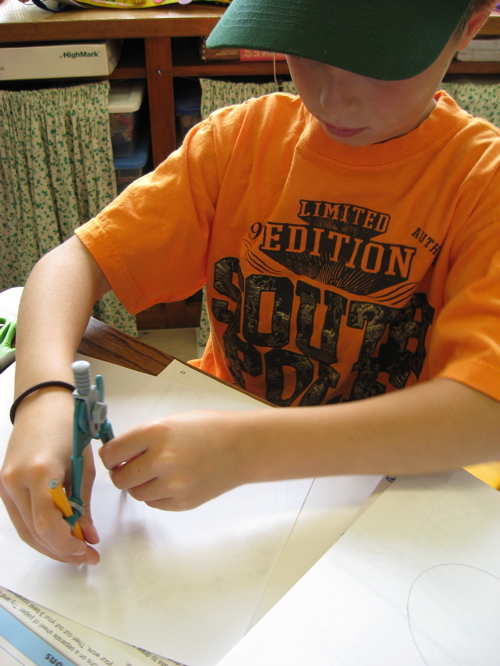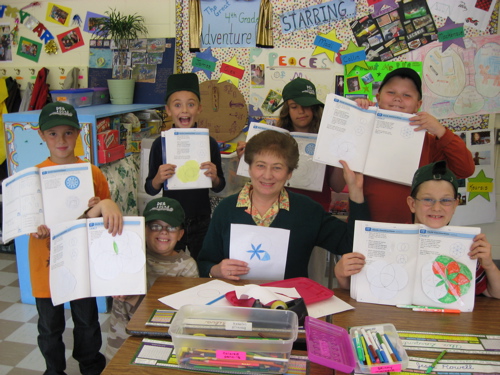In math, we take an imaginary World Tour throughout the fourth grade year. Here we are figuring out air distances between world cities using the scale on the globe.

One of the math tools that fourth graders use more extensively than ever before is the compass. We started off the math year with a stimulating geometry challenge, stretching our brains with cool vocabulary, shapes, and spatial ideas. We learned to use our compasses safely; then we created inscribed figures, concentric circles, and much more!

My favorite drawing books of all time are by Ed Emberley, and young people today are just as entranced as I was when I was in fourth grade. He starts with a geometric shape, adds another and another, and soon you have the coolest train, elephant, pirate, alligator, aircraft carrier, or . . . . ! Need a great gift idea? Go to his website and check out his nifty drawing books.
Scout’s response to our science/math connection open response problem this week:
When Madeline’s family goes camping, they freeze water in plastic jars with lids to put in their coolers to keep the food cool. Madeline filled three jars all the way to the top and screwed on the lids.
Later she went to the freezer to get the jars and found that all three jars had burst open. Her mom gave her three new jars and suggested that Madeline put in just enough water, so that when it froze, ice would fill the far just to the brim.
One jar held 500 ml, one held 1000 ml, and the third was a 2-liter bottle. Madeline remembered from science class that when they froze 45 ml of water, the ice expanded to fill 50 ml of space.
How can you use this information to figure out how much water Madeline should add to each jar so that, when it freezes, ice fills the jar just to the brim?
_______________________________________________________________________
work section:
45+45+45+45+45+45+45+45+45+45
45×10=450
45 makes 50
50×10=500
First, I read the question carefully. Then I analyzed it to see what they wanted to know. They wanted to know how much water Madeline should add to each jar so that when it freezes, ice fills the jar just to the brim. Then I checked with my smart brain to see if there were any tools I could use. I used pictures and lattice and my most valuable tool—my brain.
I drew ten 50s to make the 500 ml jar. I poured 45 ml in a jar 10 times. I did it ten times because 10×50=500. I put 450 ml in the water jar.
I knew 1,000 ml is twice as much as 500 ml. Then I figured that if the jars were twice as big, then I would need two amounts. So I used lattice to do 450×2=900 ml.
Then I knew that a 2-liter jar is two times the size of 1,000 ml. I did 900×2=1,800 ml.
Then I checked my work by reading it over to two wonderful teachers—Miss Blessing and Mr. Van. That is how I did my work today. To all the younger students reading this problem, just think and you will do your math perfectly.
500 ml jar: 450 ml 1,000 ml jar: 900 ml 2-liter jar: 1,800 ml
One of the “wicked cool” features of the Iditarod website is its interactive map. We are becoming experts on graphic sources in our reading curriculum, so we knew right what to do to read and understand the map.
We investigated sections of the trail. Some are dangerous. Some are long. Each section has its own challenges.
We shared our favorite facts. Calooloo shared that the Yentna River can be dangerous because the water slowly moves under the ice and can overflow onto the top of the ice. Chunky Monkey was fascinated by Unalakleet, where the powerful winds off the sea can complicate the race.
We used the mileage between the checkpoints to calculate our data landmarks. Here is what we found.
Minimum: 11 miles
Maximum: 112 miles
Range: 101 miles
Mode: 48 miles
Median: 46.5 miles
Mean: 46 miles
We think the mushers have to be knowledgeable mathematicians in order to plan out their racing strategy. Math is everywhere, even the Iditarod!
Part of the fun of teaching is combining the old and the new, sort of like the old poem about friendship.
“Make new friends.
Keep the old.
One is silver;
The other gold.”
(author unknown)
It is a great challenge to keep up with the newest best practice research while at the same time preserving the gems from years ago. One of my happy memories from elementary school was our annual window painting tradition at Monroe Consolidated School. Whenever I have had a classroom with the right kind of windows, I have carried on that tradition with my students, kicking off the holiday season with a rollicking time of singing and painting.
So today we jingled our bells and used our math scale skills to enlarge a design to fill the windows of our room. I end the day smiling and sending out a holiday greeting to my old teachers, wherever you are. You are not forgotten!
Is it a hot sticky day when your mind is longing for some refreshing math to think about? Try some of these activities!